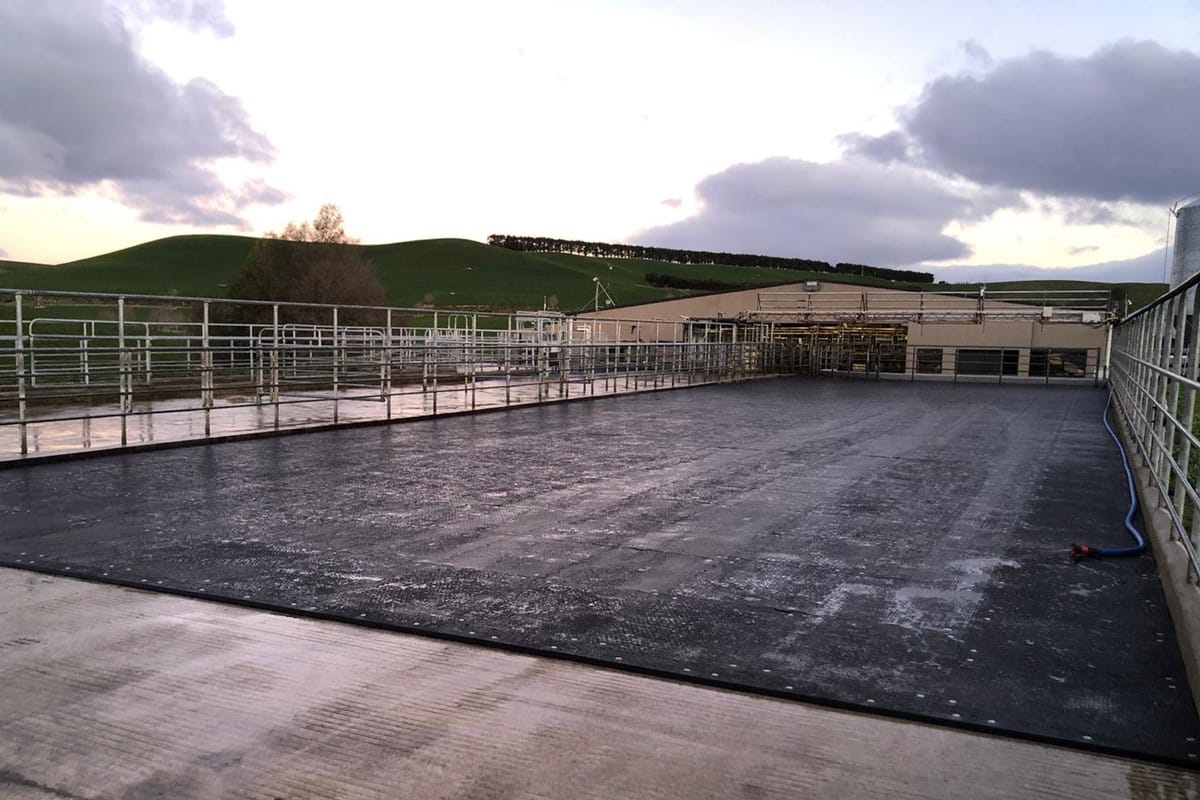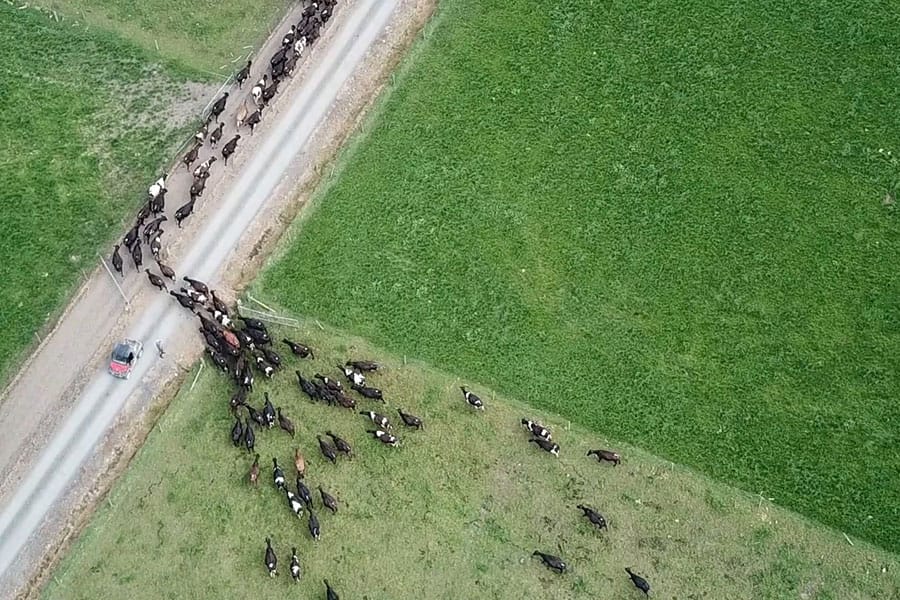How to Reduce Slipping with Rubber Matting
Ensuring the surfaces around your dairy shed are comfortable and non-slip, is one of the best ways to increase cow confidence and productivity, and reduce injuries on the farm.
Slippery floors cause cows to be uncomfortable, nervous, and more prone to injury, whether that’s when they are on the walkways, or in the yard. Cows instinctively look for less slippery areas when walking, taking their time and looking for good footing when making their way to and from the shed. There are many factors that contribute to the slipping problem and many solutions available to tackle slippery surfaces, which we will explore throughout this post.
Cows should be able to enter and exit the milking parlour in a relaxed and gentle manner. Loud noises, poor handling, and unpredictable surfaces result in jumpy, unsettled cows that make sudden movements and hurt themselves or each other. Things like sharp bends, slippery floors, glassy surfaces, and obstacles all make cows nervous and reduce their confidence, making the whole milking experience unpleasant for both them and the milking staff.
Making sure that surfaces are clean, non-slip, and ergonomic for the animals is important. Observing how your cows move and the state of their hooves will give you a good indication of the state of your surfaces and which cows are more susceptible to slipping. You will find that lower-ranking cows are more prone to slips as they are pushed to the edges of walkways by higher-ranking cows. When a cow slips on concrete, whether smooth or grooved, it’s like sandpaper to their hooves. Minimizing as many risk variables as possible is critical to the health and productivity of your stock.
Risk factors to consider linked to slipping:
- The wearing of concrete surfaces over time.
- Damage to the hoof.
- Over finished concrete surfaces.
- Competition for space amongst stock on the collection yard.
- Putting pressure on the cows to move, either by loud noises, or excessive use of the backing gate.
- Discomfort in the yard and milking parlour.
- Competition for feed when feeding systems are installed in the shed, causing pushing each other especially those that are lower ranked in the group. (https://www.numat.co.nz/case_study/rubber-surfacing-solves-slipping-herringbone-shed/)
- Slopes and steps that are not built ergonomically for purpose.

The quality of the floor surface directly correlates with the health of cows’ hooves and legs. This includes the hardness, incline, shape, friction and hygiene of the surface.
Concrete surfacing is the customary flooring on NZ dairy farms because it is relatively inexpensive, low maintenance, and easy to clean. However, it is hard, abrasive, cold, and potentially slippery, leaving room for injuries and other problems amongst your stock and staff members. Creating a comfortable and inviting environment by minimizing risks, reduces stress on the animals and makes yards and sheds more comfortable for all parties.
Softer surfaces such as rubber can be a perfect solution to reducing slipping and creating an overall more comfortable and natural environment for the cows, especially if they are required to stand for a long period of time. Maintaining surfaces to be non-slip also helps to lower stress hormones levels which results in an easier and more enjoyable milking and even calving experience.
It is essential that handling areas are kept clean, free of debris and stones, and that your surface is not slippery. Faulty and poorly maintained surfaces can be costly, leading to down cows and lameness which can greatly impact productivity. Making sure that workers are handling the animals respectfully and gently is also important. Cows do not respond well to loud yelling and aggressive methods of handling. It is in these moments of rushing and stress that injuries happen and stress levels spike, causing disruption to cow flow.
“Where before it was a regular occurrence, we’ve only had one cow go down since the matting was installed. Feedback from the vet confirmed they noticed how settled the cows were.”
– Lucas Allcock, a dairy farmer in Te Awamutu
Recommendations for best practice:
- Laneways and tracks should be constructed in a way that cows can walk comfortably, with minimum risks and potential for injury. Making sure there is no loose debris or small rocks on the tracks can help to reduce lameness.
- Surfaces in the dairy yard, milking sheds and stand-off pads should provide sturdy footing and be easy to clean, allowing effluent to wash away or be managed appropriately.
- If not covered with rubber matting, concrete areas can be grooved to increase friction to reduce slips. However, be careful as it can increase hood wear and Whiteline issues. Grippy, durable rubber matting is the ideal alternative to this.
- If possible, allow for concrete areas to dry after cleaning. This will not only make the milking experience more comfortable but also help to reduce slipping.
- Interactions between cows and the workers should be calm and gentle. Yelling is stressful and causes an unpleasant environment to be in. When the animals feel panicked and rushed they are more likely to injure themselves and each other.
- Reduce the amount of time that cows are standing on concrete. Concrete surfaces are uncomfortable and too hard on them and can be especially painful for lame cows. Installing rubber matting allows you to stand off cows for greater lengths of time.

Concrete isn’t made for cows.
Concrete surfacing is still a very popular surfacing option here in New Zealand, but cows aren’t meant to be on these concrete floors for long periods of time. Cows that spend long waiting times on concrete or walk long distances can be prone to suffer from excessive wear and overburdening of their hooves.
The ideal surface should be comfortable, hygienic, and slip-resistant. From a farmers perspective, they should also be durable, simple to install, and easy to maintain. Slippery concrete surfaces should be grooved to make them less slippery. Making sure that rough and sharp edges are sanded down is also important to prevent hoof injuries. A durable rubber alternative might also be an answer. Alongside providing a solution to slipping, a rubber surface can help facilitate better cow flow and comfort, and reduce cleaning times. Trying to reduce excessive standing and walking time is also encouraged.
The hygienic state of the surfacing cows stand on is also important to consider. Dairy cows should be on surfacing that allows for their hooves to be dry as possible. Dairy cows’ hooves absorb water easily making the hooves softer, which increases the risk for future injuries and lameness. Making sure that you have a surface that can be kept clean and that drains well is critical. Keeping the surface as dry and clean as possible means fewer slips and a more comfortable environment for the cows to be in. It makes the cows more confident knowing what they are standing on and they are not hesitant or worried about stepping on something or missing their footing. Observe your cows and see how they step, what hesitations they have, where they stop and why they stop on their walk to and from the shed, and how they interact with each other when they are together in the yard. This provides a good opportunity to assess your surfaces and makes sure that they are not too slippery and that they are encouraging good cow flow.
Is rubber matting the answer?
We have observed that cows prefer to stand on rubber surfacing rather than concrete. Installing good quality, fit for purpose rubber surfacing is a great investment to make into your dairy farm. Not only does it make your cows safer, more comfortable, and less likely to get hoof problems, but it also helps extend the life of your concrete surfacing by adding a durable protective layer. Rubber matting creates coverage that feels more pasture-like for the cows and accommodates their normal behaviour without adding the stress of slips and injuries. It makes the cows comfortable in the milking shed and makes the environment far more inviting for them and your workers.
Rubber matting isn’t the solution for slips on the dairy farm, there are a number of preventative measures you can take to reduce slipping on your far, but rubber matting can be part of the solution. By reducing potential hazards, rubber matting can save you a lot of time, energy, and money otherwise spent on down cows, maintenance of concrete, and repair of tracks.
Here at Numat we have been listening and working with farmers for a long time and we have created a specialised range of products specific to each area of your farm and what issues you might be facing. Our rubber mats are designed and fit for purpose to help stock management and make sure the animals are comfortable and safe.
Farmers come to us for rubber matting every day. Those that install it, swear by it. Some of them even let us interview them on camera for this website. We encourage you to watch those videos below and decide for yourself.
